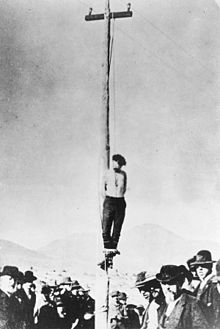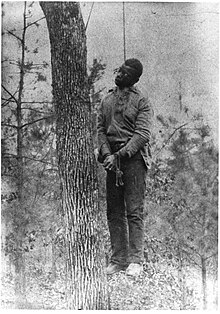Lynching in the United States
Lynching in the United States
Lynching is the practice of murder by a group by extrajudicial action. Lynchings in the United States rose in number after the American Civil War in the late 1800s, following the emancipation of slaves; they declined in the 1920s but have continued to take place into the 21st century. Most lynchings were of African-American men in the South, but women were also lynched, and white lynchings of blacks occurred in midwestern and border states, especially during the 20th-century Great Migration of blacks out of the South. The political message — the demonstration of white male supremacy and black male impotence — was a key element of the ritual. On a per capita basis lynchings were also common in California and the Old West, especially of Latinos, although they represented less than 10% of the national total. Native Americans and Asian Americans were also lynched.[1] Other ethnicities (white, Finnish-American, Jewish, Irish, Italian-American) were occasionally lynched.
The stereotype of a lynching is a hanging, because hangings are what crowds of people saw, and are also easy to photograph.[2] Some hangings were professionally photographed and sold as postcards, which were popular souvenirs in some parts of the U.S.[3][4] Victims were also killed by mobs in a variety of other ways: shot repeatedly, burned alive, forced to jump off a bridge, dragged behind cars, and the like. Sometimes they were tortured as well, with body parts sometimes removed and sold as souvenirs.[5] Occasionally lynchings were not fatal (see Lynching survivors in the United States). A "mock" lynching, putting the rope around the neck of someone suspected of concealing information, might be used to compel "confessions".[6]:38–39
According to the Tuskegee Institute, 4,743 people were lynched between 1882 and 1968, including 3,446 African Americans and 1,297 whites. More than 73 percent of lynchings in the post-Civil War period occurred in the Southern states.[7]
Lynchings were most frequent from 1890 to the 1920s, with a peak in 1892. Lynchings were often large mob actions, attended by hundreds or thousands of watchers, sometimes announced in advance in newspapers and in one instance with a special train. However, in the later 20th century lynchings became more secretive, and were conducted by smaller groups of people. The word "lynching" is no longer used to describe new events, but there are "deaths", "murders", and "assassinations" as recently as 2011 that are lynchings in everything but name The word "lynching" is no longer used to describe new events, but there are "deaths", "murders", and "assassinations" as recently as 2011 that are lynchings in everything but name.[citation needed]
On April 26, 2018, in Montgomery, Alabama, the National Memorial for Peace and Justice opened. Founded by the Equal Justice Initiative of that city, it is the first large memorial to document lynchings of African Americans in the United States.




